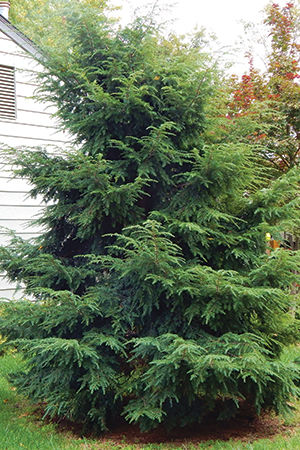Although Oklahoma’s winters are not as long and severe, nor blanketed with snow as more northern areas, evergreens, and particularly conifers, are a welcome sight and a relief from the brown, dormant landscape.
Back in the late ’70s, when the City of Tulsa’s park horticulture department was planting the azaleas in Woodward Park, I found and planted several Canadian hemlock trees (Tsuga canadensis) among the azalea beds in the shade of the oaks. Many of those hemlock trees are still there and thriving as handsome specimens.
Don’t let the Canadian in this tree’s name mislead you because this native North American tree grows from Nova Scotia in Canada to Minnesota and south along the mountains of Alabama and Georgia. Dr. Michael Dirr, horticultural professor at the University of Georgia, Athens, says, "It is one of the most beautiful of all the conifers and one of our best evergreens."
These trees transplant easily and grow in a natural pyramidal shape, often with multi-trunks. Here in Tulsa, specimens can grow to about 25 feet tall and 10-15 feet wide.
The small needles are ½- to ¾-inch long and have two silver bands on the leaf’s underside. Ripening in the fall, delightfully miniature ½- to ¾-inch brown cones dangle from the branches. The tree’s bark is rich brown and deeply furrowed on older trees.
Canadian hemlock likes a well-drained, acidic and moist soil and will grow best in shade as an understory tree, underneath the main canopy. When growing in sun, it needs a location without strong, drying winds. This also is a tree for sandy or rocky soils, but it does not tolerate drought and wind.
The best time to plant a tree, including the Canadian hemlock, is in fall or winter. There are no noticeable pests on the local trees I’ve observed.
Plant Canadian hemlock as a specimen plant — a plant placed conspicuously alone, usually in a prominent place, to show its ornamental qualities — or in groupings. It makes excellent trimmed evergreen hedges, so use it for screening and foundation plantings. Several dwarf and prostrate cultivars are offered in the nursery trade. "Sargent" is a weeping cultivar.
Locally, Sander’s Nursery in Broken Arrow and Inola offer and can order Canadian hemlock.










(0) comments
Welcome to the discussion.
Log In
Keep it Clean. Please avoid obscene, vulgar, lewd, racist or sexually-oriented language.
PLEASE TURN OFF YOUR CAPS LOCK.
Don't Threaten. Threats of harming another person will not be tolerated.
Be Truthful. Don't knowingly lie about anyone or anything.
Be Nice. No racism, sexism or any sort of -ism that is degrading to another person.
Be Proactive. Use the 'Report' link on each comment to let us know of abusive posts.
Share with Us. We'd love to hear eyewitness accounts, the history behind an article.